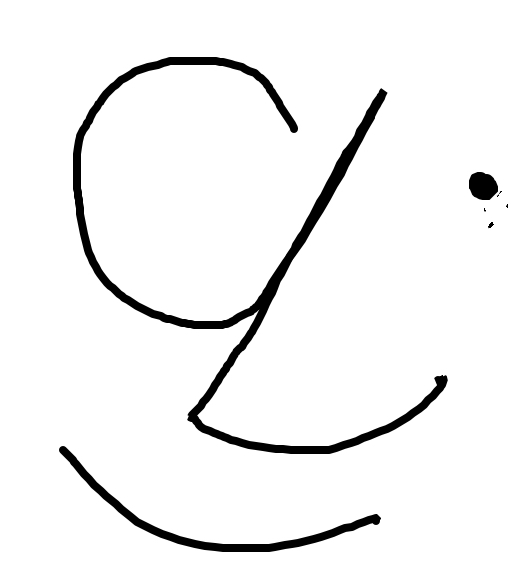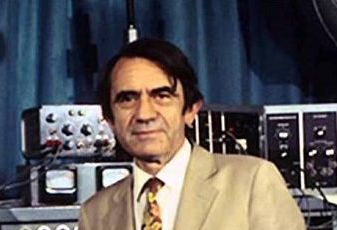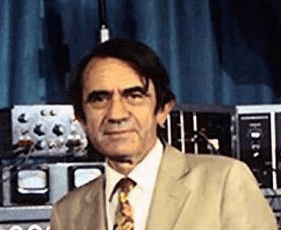Pierre Schaeffer (1910-1995) : the father of concrete music.
“Listening means giving attention to everything that sounds”.
Pierre Schaeffer
With Pierre Schaeffer, the passing train, the rustling of paper, and the sound of the wind become sound material, an invitation to listen differently.
First of all, I must clear up a confusion I myself had: musique concrète is not performed live with everyday objects or tools, diverted from their usual use to create a musical discourse.
These objects are recorded, then worked on, dissected in the laboratory to build a bank of “sound objects” later used in musical compositions. These initial experiments were based on “concrete” sound bodies rich in acoustically sourced vibrations. Only a few years later were electroacoustic sounds added.
The best introduction to Schaeffer’s work is perhaps an excerpt from an interview (in french) about “Variations sur une flûte mexicaine.”
And now, some aspects of his works:
- Introduction to musique concrète: Étude aux chemins de fer, L’oiseau RAI, Variations sur une flûte mexicaine (1948-49)
- Orphée, in collaboration with Pierre Henry (1953)
- Étude aux objets (1959)
A major figure in 20th-century musical creation, Pierre Schaeffer ultimately did not see himself as a composer but as a researcher. He quickly rejected the term “musique concrète” in favor of “experimental music.” He was very aware that his research would contribute to the emergence of another type of music, alongside a new perspective on sounds and noises.

Pierre Schaeffer (1910-1995) was a French engineer, researcher, theorist, composer, and writer. He was also a radio man, founder, and director of numerous services.
You can find out more about the titles followed by * at
“To find out more …”.
What is concrete music?
Decidedly acoustic, concrete music seeks its material in sound bodies, whose sound is captured by a microphone and generally manipulated after recording, either mechanically (by editing or varying playback speed) or electrically (by filtering frequency spectra and amplification).
Concrete music is not electronic music, where sounds are artificially produced and do not exist in nature. However, a strong link developed between these two currents in the 20th century, with musical works simultaneously using techniques inherent to both genres, leading to acousmatic music.
Why did Pierre Schaeffer say that concrete music “was not music”?
Pierre Schaeffer invented musique concrète not as a style but as an experiment in listening. He wanted to ask: “What is music if we no longer work with written notes but with recorded sounds?”
After his early works, he observed:
- Many concrete pieces remained collages of sounds without clear musical language.
- There was sometimes a lack of emotional and poetic structure linking the sounds.
- This research was exciting but did not always produce what he considered “music.”
“What I did was not music, it was research that asked the question of music.”
Pierre Schaeffer
He therefore preferred to continue thinking about and teaching listening, leaving other composers to extend musique concrète in various artistic directions, notably one of his first collaborators: Pierre Henry
Pierre Schaeffer’s catalog of compositions is relatively small, and in retrospect, his works may not really be intended to be listened to as musical works. However, they remain very interesting to know, which is why I present them here!
Podcast *
I highly recommend reading the fascinating texts in this podcast, translated into English and available as a PDF link.
Études de bruits (1948) *
00:00 Étude aux chemins de fer – trains 02:53 Étude aux tourniquets – toy tops and percussion instruments 04:52 Étude violette – piano recorded for Schaeffer by Boulez 08:12 Étude noire – piano recorded for Schaeffer by Boulez 12:11 Étude pathétique –
saucepans, barges, singing, speeches, harmonica, piano
Variations on a Mexican Flute (1949)
This piece is perhaps the clearest to understand Schaeffer’s work: in this recording, he used nothing but the first 8 notes of the flute, processed in his laboratory to extract attacks (percussive material), and experimented with speed, layering, etc.
The bird RAI (1949)
Suite for 14 instruments (1949)
I. Prélude
II. Courante-roucante
III. Rigodon
IV. Vagotte-gavotte
V. Sphoradie
Suite des 5 Mouvements
Orphée 53 (1953)
Orphée 53, in collaboration with Pierre Henry, “concrete opera” for three voices, harpsichord, violin, and tape, 1953.
I. Prologue II. Premier air d’Orphée [01:15] III. Premier récitativ d’Orphée [03:17] IV. Les Monstres [06:37] V. Parade d’Eurydice [10:00] VI. Débat d’Orphée [13:24] VII. Rupture finale [18:39]
Etude aux objets Part 1-5 (1959) *
0:00 Exposed objects 3:37 Extended objects 6:35 Multiplied objectss 9:40 Linked objects 12:50 Gathered objects
The musical object
The musical experience was a series of 6 radio broadcasts, but it’s in French… Here is a jubilant yet indigestible sequence due to the complexity and number of explanations. To fully understand, it would take about ten listens!
Solfège of the sound object (1967) *
Audio complement to the Treatise on musical objects.
Prologue: the four elements of solfège – Pierre Schaeffer, narrator.
You will find the PDF text in “For further information…”
Comparative listening corner…
Bidule en ut (1950)
Bilude (1979)
“Study on railways”
Original version by Pierre Schaeffer (1948)
2011 revisited version by Pierre Borel (saxophone) & Hannes Lingens (snare drum & objects).
Video performance.
For further information…
Biographical elements around “Five Noise Studies” and “Study of objects”.
In addition to his innovative work as a composer, Schaeffer was also a music theorist and an accomplished man of letters, as shown by his numerous writings. Born in 1910, he first pursued technical and scientific studies and worked as a telecommunications engineer and sound technician from 1934 before considering a composer’s career. His professional experience, combined with basic cello knowledge, allowed him to create his first musique concrète works, including Cinq Études des bruits in 1948, followed by the direction of the Groupe de Recherches de Musique Concrète (GRMC) from 1951 to 1953, later renamed Groupe de Recherches Musicales (GRM) and merged in the 1970s with the Institut National de l’Audiovisuel to form INA GRM.
He intensified his theoretical reflections, which he had begun very early, at the expense of his musical practice, notably to determine his conception of music: Schaeffer believed that Western music deprived itself of an important sphere by focusing on traditional instruments and thus on fixed pitches. His questioning of traditional instruments and the listening experience associated with Varèse, Cage, and Messiaen informed his professional evolution toward composition and working on sounds in concrete music.
Described by Möller as Schaeffer’s “major work,” Study of objects” can be interpreted as “the result of research on domestication possibilities” and constitutes Schaeffer’s last major composition. He did not place much importance on his own compositional practice and continually questioned his abilities as a musician. It represents a succession of several small studies, after which Schaeffer completely abandoned composition for a long period. The work argues that it should represent the conclusion of the composer’s musical vision, resulting in “a complete revolution in the composer’s craft.” To achieve this, only original sounds collected over the years were used, which were only edited, mixed, and transposed at most. Schaeffer considered his composition as a “landscape” where “the musical objects […] were deployed to form the basic sound material that will never be betrayed.”
Solfège of the sound object
For translation purposes, I transcribed the text spoken by Pierre Schaeffer in the Prologue recording.
The timings correspond to the sound examples. Click on this link. Cliquez sur ce lien.
And here is a film (in french) in which composer Beatriz Ferreyra presents the solfège of the sound objects of Pierre Schaeffer, with whom she actively collaborated alongside Guy Reibel.
Podcast on Pierre Schaeffer, in french…
https://embed.radiofrance.fr/francemusique/diffusion/2745b095-f0a9-42da-9938-434b02f4ff6d
English translation of the full podcast text.


